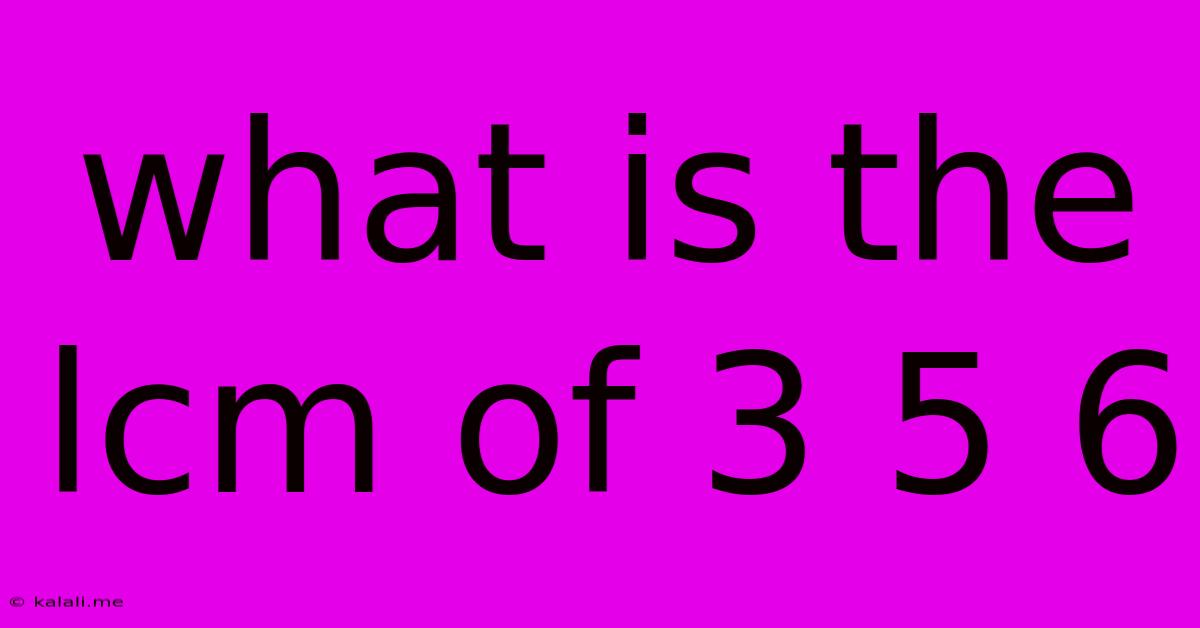What Is The Lcm Of 3 5 6
Kalali
Jun 15, 2025 · 2 min read

Table of Contents
Finding the Least Common Multiple (LCM) of 3, 5, and 6
This article will guide you through the process of calculating the Least Common Multiple (LCM) of 3, 5, and 6. Understanding LCM is crucial in various mathematical applications, from simplifying fractions to solving problems involving cycles and rhythms. This explanation will provide a clear understanding of the concept and the steps involved in finding the LCM, particularly for the numbers 3, 5, and 6.
What is the Least Common Multiple (LCM)?
The Least Common Multiple (LCM) of two or more integers is the smallest positive integer that is divisible by all the integers. It's the smallest number that contains all the given numbers as factors. Think of it as finding the smallest number that can be divided evenly by all the numbers in your set.
Methods for Calculating LCM
There are several ways to calculate the LCM. We'll explore two common methods: the listing method and the prime factorization method. Both methods will arrive at the same answer, but one might be more efficient depending on the numbers involved.
1. Listing Multiples Method
This method involves listing the multiples of each number until you find the smallest multiple that is common to all.
- Multiples of 3: 3, 6, 9, 12, 15, 18, 21, 24, 27, 30...
- Multiples of 5: 5, 10, 15, 20, 25, 30...
- Multiples of 6: 6, 12, 18, 24, 30...
By examining the lists, we can see that the smallest number that appears in all three lists is 30. Therefore, the LCM of 3, 5, and 6 is 30. This method is suitable for smaller numbers; for larger numbers, it can become quite tedious.
2. Prime Factorization Method
This method is generally more efficient, especially when dealing with larger numbers. It involves finding the prime factorization of each number and then constructing the LCM using the highest powers of all prime factors present.
- Prime factorization of 3: 3
- Prime factorization of 5: 5
- Prime factorization of 6: 2 x 3
To find the LCM, we take the highest power of each prime factor present in the factorizations:
- Highest power of 2: 2¹ = 2
- Highest power of 3: 3¹ = 3
- Highest power of 5: 5¹ = 5
Now, multiply these highest powers together: 2 x 3 x 5 = 30. Therefore, the LCM of 3, 5, and 6 is 30.
Conclusion: The LCM of 3, 5, and 6
Using both the listing method and the prime factorization method, we've conclusively determined that the Least Common Multiple of 3, 5, and 6 is 30. Understanding these methods equips you with the skills to efficiently calculate the LCM for any set of integers, making it a valuable tool in various mathematical contexts. Remember to choose the method that best suits the numbers you are working with – the prime factorization method generally provides a more streamlined approach for larger numbers.
Latest Posts
Latest Posts
-
Which Of The Following Is Not An Element Of Tqm
Jun 16, 2025
-
What Two Bodies Of Water Does The Suez Canal Connect
Jun 16, 2025
-
Which Of The Following Is True Regarding
Jun 16, 2025
-
Which Of The Following Vitamins Is Not Fat Soluble
Jun 16, 2025
-
A Community Of Interdependent Organisms And Their Physical Environment
Jun 16, 2025
Related Post
Thank you for visiting our website which covers about What Is The Lcm Of 3 5 6 . We hope the information provided has been useful to you. Feel free to contact us if you have any questions or need further assistance. See you next time and don't miss to bookmark.